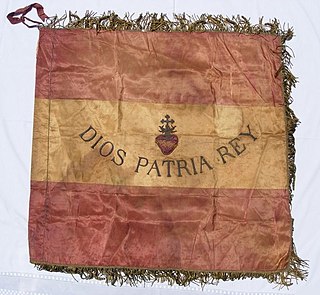
Carlism is a Traditionalist and Legitimist political movement in Spain aimed at establishing an alternative branch of the Bourbon dynasty – one descended from Don Carlos, Count of Molina (1788–1855) – on the Spanish throne.
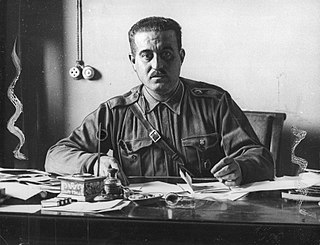
Manuel Fal Conde, 1st Duke of Quintillo was a Spanish Catholic activist and a Carlist politician. He is recognized as a leading figure in the history of Carlism, serving as its political leader for over 20 years (1934–1955) and heading the movement during one of its most turbulent periods. Initially he led the belligerent faction pressing anti-Republican insurgency; during the Spanish Civil War he joined the Nationalists; later on he championed the anti-Francoist strategy.

Juan Olazábal Ramery (1863–1937) was a Spanish Traditionalist politician, first as a Carlist, then as an Integrist, and eventually back in the Carlist ranks. In 1899-1901 he served in the Cortes, and in 1911-1914 he was a member of the Gipuzkoan diputación provincial. Between 1897 and 1936 he managed and edited the San Sebastián daily La Constancia. He is best known as the nationwide leader of Integrism, the grouping he led between 1907 and 1931.

Manuel Senante Martínez (1873–1959) was a Spanish Traditionalist politician and publisher, until 1931 adhering to the Integrist current and afterwards active in the Carlist ranks. He is known mostly as the longtime editor-in-chief of the Madrid daily El Siglo Futuro (1907–1936). During 8 consecutive terms he served as the Integrist deputy to the Cortes (1907–1923).

Electoral Carlism of Restoration was vital to sustain Traditionalism in the period between the Third Carlist War and the Primo de Rivera dictatorship. Carlism, defeated in 1876, during the Restauración period recalibrated its focus from military action to political means and media campaigns. Accommodating themselves to political framework of the Alfonsine monarchy, the movement leaders considered elections, and especially elections to Congreso de los Diputados, primary vehicle of political mobilization. Though Carlist minority in the Cortes remained marginal and its impact on national politics was negligible, electoral campaigns were key to sustain the party until it regained momentum during the Second Spanish Republic.

Ramón Nocedal Romea (1842-1907) was a Spanish Catholic ultraconservative politician, first member of the Neocatólicos, then of the Carlists, and finally of the Integrists. He is known as leader of a political current known as Integrismo (1888-1907) and a chief representative of Catholic fundamentalism when applied to politics.

Integrism was a Spanish political philosophy of the late 19th and early 20th century. Rooted in ultraconservative Catholic groupings like Neo-Catholics or Carlists, the Integrists represented the most right-wing formation of the Restoration political spectrum. Their vision discarded religious tolerance and embraced a state constructed along strictly Catholic lines; the Integrists opposed Liberalism and parliamentarian system, advocating an accidentalist organic regime. Led first by Ramón Nocedal Romea and then by Juan Olazábal Ramery they were active as a political structure named Partido Católico Nacional, but the group retained influence mostly thanks to an array of periodicals, headed by the Madrid-based El Siglo Futuro. Though Integrism enjoyed some momentum when it formally emerged in the late 1880s, it was soon reduced to a third-rate political force and eventually amalgamated within Carlism in the early 1930s.

Claro Abánades López was a Spanish journalist, publisher, historian and a Carlist activist. His career of a journalist lasted over 70 years (1897–1969), though he is rather known as author of studies on history of Alcarria and as editor of monumental multi-volume series of Juan Vázquez de Mella works.
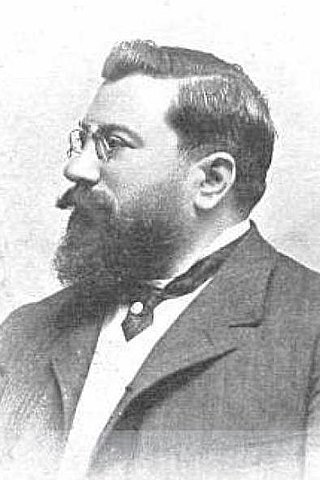
Mellismo was a political practice of Spanish ultra-Right of the early 20th century. Born within Carlism, it was designed and championed by Juan Vázquez de Mella, who became its independent political leader after the 1919 breakup. The strategy consisted of an attempt to build a grand ultra-Right party, which in turn would ensure transition from liberal democracy of Restauración to corporative Traditionalist monarchy. Following secession from Carlism Mellismo assumed formal shape of Partido Católico-Tradicionalista, but it failed as an amalgamating force and decomposed shortly afterwards. Theoretical vision of Mella is usually considered part of the Carlist concept and does not count as Mellismo; the strategy to achieve it does. In historiography its followers are usually referred to as Mellistas, though initially the term Mellados seemed to prevail. Occasionally they are also named Tradicionalistas, but the term is extremely ambiguous and might denote also other concepts.

Manuel de Llanza y de Pignatelli de Aragón, Hurtado de Mendoza y Esquivel, 9th Duke of Solferino, 11th Marquis of Coscojuela, 13th Count of Centelles, grandee of Spain (1858–1927) was a Spanish Carlist politician. In the late 19th century he emerged as one of party leaders in Catalonia and was its regional jefe in two separate strings of 1910–1914 and 1917–1919. He is recognized as typical example of inner-circle aristocrat ruling the party during the Restoration period.

Luis Gonzaga María Antonio Carlos Ramón Miguel de Llauder y de Dalmases, de Freixas, de Bufalá y de Camín, 1st marquis of Valldeix (1837–1902) was a Spanish Catholic publisher and a Carlist politician. He is known as leader of Catalan Carlism of the late nineteenth century. He is also recognized as founder and the moving spirit behind Barcelona-based Catholic media initiatives, especially a publishing house, a daily Correo Catalán, and a weekly La Hormiga de Oro.
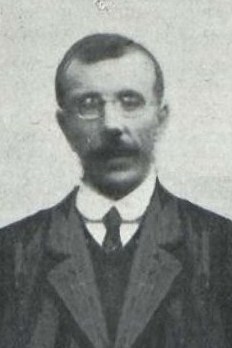
José Benigno Sánchez Marco (1865-1949) was a Spanish Traditionalist politician, associated mostly with a branch known as Integrism and operating as Partido Católico Nacional, though active also within the mainstream Carlism. He is recognized as one of the longest-serving Integrist deputies to the Cortes, his 4 consecutive terms lasting between 1905 and 1916. He also presided over a number of Navarrese Catholic and landowners’ organizations.

Traditionalism is a Spanish political doctrine formulated in the early 19th century and developed until today. It understands politics as implementing the social kingship of Jesus Christ, with Catholicism as the state religion and Catholic religious criteria regulating public morality and every legal aspect of Spain. In practical terms it advocates a loosely organized monarchy combined with strong royal powers, with some checks and balances provided by organicist representation, and with society structured on a corporative basis. Traditionalism is an ultra-reactionary doctrine; it rejects concepts such as democracy, human rights, constitution, universal suffrage, sovereignty of the people, division of powers, religious liberty, freedom of speech, equality of individuals, and parliamentarism. The doctrine was adopted as the theoretical platform of the Carlist socio-political movement, though it appeared also in a non-Carlist incarnation. Traditionalism has never exercised major influence among the Spanish governmental strata, yet periodically it was capable of mass mobilization and at times partially filtered into the ruling practice.

The Traditionalist Communion was one of the names adopted by the Carlist movement as a political force since 1869.

In terms of electoral success Carlism of the Second Spanish Republic remained a medium-small political grouping, by far outperformed by large parties like PSOE and CEDA though trailing behind also medium-large contenders like Izquierda Republicana. During three electoral campaigns to the Cortes combined the Carlists seized less than 50 seats, which is below 3% of all seats available. Disorganized during the 1931 elections, the Carlist candidates were a first-choice political option for some 50,000 voters; following re-organization in successive campaigns the number grew to 420,000 (1933) and 365,000 (1936), respectively 4.9% and 3.8% of active electors. In the mid-1930s as a second-choice option the Carlists were acceptable candidates for some 1.8m voters (18%). The movement enjoyed support mostly in the Northern belt of Spain; the party stronghold was Navarre, the only region where Carlism remained a dominating force; it was a minority group still to be reckoned with in Vascongadas, Old Castile and Aragón, with rather testimonial presence in some other regions. The best known Carlist Cortes personality was Tomás Domínguez de Arévalo, who held the mandate during all three Republican terms.

Rafael Díaz Aguado Salaberry (1870-1942) was a Spanish Carlist politician, active in particular during the final years of the Restoration regime and during the Second Republic. He is best known as deputy to the Cortes during two terms between 1907 and 1914. During the Civil War he periodically headed the Carlist underground relief organisation Socorro Blanco, operational in the Republican-held Madrid.

Francisco Estévanez Rodríguez (1880–1953) was a Spanish politician, publisher, philanthropist, agrarian syndicalist and religious activist. He is best known as deputy to the Cortes during two terms between 1931 and 1936. Politically he was a Traditionalist, first member of the Integrist branch and then active within Carlism. He also published two small Burgos periodicals, continuously donated money and supported various charity schemes, strove to build rural trade unions which unite landholders and farmers, and was involved in numerous Catholic initiatives usually related to the Burgos archbishopric office.

Bernardo Elío y Elío, 7th Marquess of Las Hormazas (1867–1937), was a Spanish aristocrat and politician. He supported the Carlist cause. During the late Restoration period he formed part of the regional Aragon party executive, but is known mostly as the local Traditionalist leader in the province of Gipuzkoa, especially during the lifetime of the Second Spanish Republic; he briefly served also in the supreme party executive, but did not play a major role in shaping the nationwide party politics. He was a typical example of an inner-circle aristocrat ruling the local Traditionalist structures.
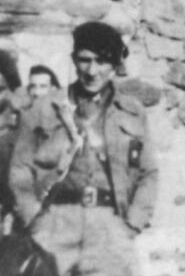
José María Mazón Sainz (1901-1981) was a Spanish lawyer and a Traditionalist politician. In the early 1930s he was active within Carlism and rose to party leader in the province of Logroño. Engaged in the coup of July 1936, during the Spanish Civil War he favored unification into the state party. His political career climaxed at the turn of the decades; in 1937-1938 he held a seat in the first Falange Española Tradicionalista executive Junta Política and in 1937-1942 during two first terms he was member of another top party structure, Consejo Nacional. In return, he was expulsed from Comunión Tradicionalista. In the early 1940s he withdrew from politics and led a Madrid law firm.
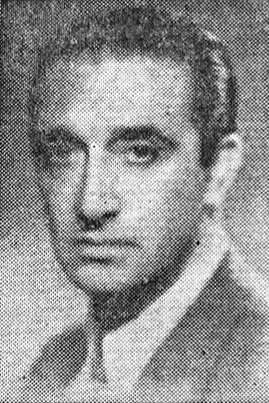
Ignacio Romero Raizábal (1901-1975) was a Spanish writer and a Carlist activist. In the 1930s in Cantabria he gained some local recognition as a poet, while in the early Francoist era he was moderately known nationwide as the author of novels and historiographic accounts; he published some 35 volumes in total. In the 1930s he headed a Traditionalist review Tradición; during the post-war period he contributed mostly to Carlist periodicals, especially the daily El Pensamiento Navarro and the monthly Montejurra. He did not engage in politics, though he briefly served as secretary to the regent-claimant Don Javier and was one of key Carlist propagandists. Since the early 1960s, when the movement was subject to struggle for domination between traditionalists and progressists, Romero assumed an in-between position.






















